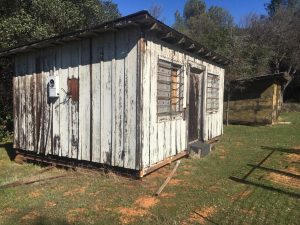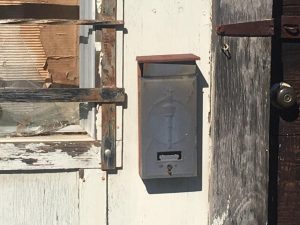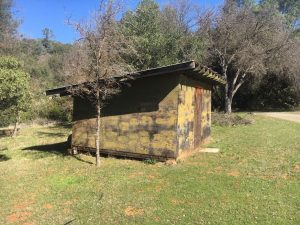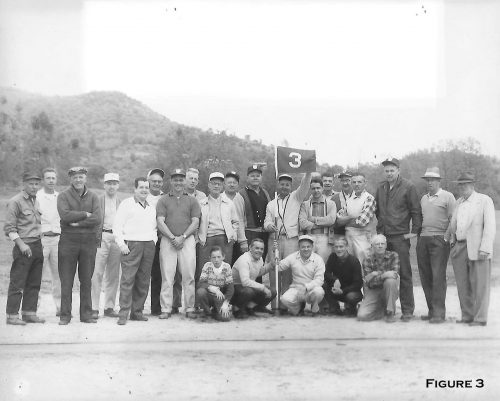Early History of Golf in Tuolumne County
By Ron Kopf, Peak & Associates, Inc.
A ninety-two-acre parcel, located in Jamestown on the north side of golf links road, was previously the home of Sonora’s first Golf Club. Although identified by some as beginning in the 1930s, reference articles show that the Sonora Golf Club appears to date back to 1925. On February 8, 1925, the first meeting of the proposed golf club was held at the Victoria Hotel for about 50 golf enthusiasts who gathered to discuss plans. Paul J. Cooper was selected as the temporary chairman with George Griffin temporary secretary. The president of the Turlock Country Club, accompanied by Ian MacDonald, gave a talk on organizing a group (Stockton Independent 9 February 1925). Ian MacDonald, a professional golfer, had signed up a large number of interested members to give them indoor practice and also was to assist in selecting a course site. The committee with MacDonald went out on that date to look at a prospective site (Stockton Independent 13 February 1925).
Ian MacDonald was born in Inverness, Scotland in 1882, and moved to Washington in 1916. He resided for a few years in Enterprise, Oregon, working as a merchant. He went on to begin work as a golf professional by 1919, at which point he and wife Vesta lived in Santa Cruz (Santa Cruz Evening News 1991; Federal Census 1920). He became the golf professional in Stockton in 1921, then moved to work in Modesto, to work at the Stanislaus Country Club. His columns on club activities and tournaments were featured in the Modesto Evening News. In 1924, he resigned after 18 months at the Club, and became the professional for the Turlock Country Club (Modesto Evening News 12 September 1924). A few months later, he married Mrs. Hilda Cressey, widow of Albert Cressey, and a leading member of the Stanislaus Country Club (Modesto Evening News 21 January 1925).
On February 12, 1925, the Sonora Golf Club was organized with a committee of nine appointed to act as a temporary organization committee until the club could be legally incorporated and the committee would become the permanent board of directors. The initial committee included: H. A. Burkart, James E. Miller, Charles H. Segerstrom, J. E. Baer, J. F. Symons, Charles H. Noack, Paul J. Cooper, C. N. Hamblin and D. H. Chambers.
After incorporation, stock was to be issued to each member. The membership would be about 100, and then be closed. Anyone accepted after the closure would be known as affiliated members. A set of rules would then be formulated including monthly dues and fees for non- member to pay.
The effort to form the Golf Club was earnest, and on February 26, 1925, the nascent Sonora Golf Club was created. T.F. Symons was elected president, H.A. Butchart, vice president, and J. B. Miller, secretary-treasurer. The committee was still looking for the site of the golf grounds (Stockton Independent 27 February 1925).
By April of 1925, the Sonora Golf Club course had been partially built, with six holes ready for use, and local amateurs reportedly “getting into shape for their first game.” The course was “situated on the old Doherty ranch between Sonora and Jamestown (Stockton Independent 20 April 1925).
Doherty had acquired the land in 1882, and was it likely used for grazing cattle at least through 1906. The land was later sold to a farmer, Peter Barendregt. Barendregt and others conveyed the 102.35 acres of land in 1930 to T. F. Symons as the Trustee for the Sonora Golf Course. (Tuolumne County Deeds 95:316).
No mention is made of the golf club in local papers after this, nor in many records. There are several possible reasons for this:

- The Sonora Golf Club did not complete a course for some years, and never followed through on the initial plan to distribute shares. The Great Depression, beginning in 1929, may have also created a financial barrier to completing improvements for a pastime.
- The Twain Harte Lodge began construction at the same time, and a golf course was planned. In 1926, they started selling lots to the public, again promising a future golf course (Stockton Independent 21 February 1925; Madera Tribune 16 June 1926).
- The small size and lack of a clubhouse may have not encouraged the development of the group and facility.
The layout of the golf course was never shown on a map, including the Sonora 1949 USGS topographic map, the California Highway Transportation Survey of 1934 and the 1939 Metzger’s Tuolumne County Map.
The Sonora Golf Course: The Later Years
One individual who remembers the golf course well is Norbert “Norby” Wilson, a local Tuolumne resident, born in 1950. Norby remembers the golf course as the “Sonora Country Club.” He first played the course in about 1963 or 1964. He describes the site as a cow pasture, established by a group who cut down trees to make the course. He played there through 1968 on the high school team, before switching to the then newly-opened Phoenix Lake golf course for his senior year of high school.

Norby described the 9-hole course as a somewhat unique rough course. Every fall, there would be a get-together at the course and a controlled burn would be conducted to rid the course of grass and weeds. Fire trucks from the surrounding communities of Jamestown, Columbia and Sonora would assist in the burn. The grass would re-grow over the winter and be very lush in the spring. They would mow the course with an old tractor and gang mower. The mower was stored in the tractor shack that is now located on the adjacent property, next to the office. The office had a mail box on the front for paying a donation fee for playing the course on an honor system, primarily used for gas for the mowing operation. Scorecards were also available in the box.
The course was played for about three to four months of the year in the spring, and the golfers abandoned play when the weeds (goat heads, also known as puncture vine) grew back, making it too hard to play. The course was not visited again until it was time to burn the vegetation in the late fall.

The golf course did not have the type of golf greens we are familiar with today. Greens were composed of compacted sand and a shot would be made toward the flag in the middle of the green. The distance from the flag was measured with a string tied to the pin, and the ball would then be placed on a length of oiled sand for putting to the cup from the measured distance. The oiled sand was held in place between 2×4’s and was four to five feet wide. Prior to putting, the oiled sand was flattened with a dragged piece of carpet.
Norby did not know exactly when the course was built. He thought there was an early group, who were involved in the initial development with the course that then fell into disuse during the Depression and World War II. When men came home from their military service after the War, the course was brought back into use with many playing the course into the late 1940s-1950s. A subsequent third group where the young men who grew up playing the course in the 1960s that included Norby and his friends. They rounded up six schoolmates and formed a high school golf team that practiced on the course. They often had problems when they traveled to play other teams, at regular courses in the valley since they had no experience putting on a maintained green with real grass.
Norby still lives in Sonora and continued to play other local courses as they were developed over the years in Tuolumne County and often traveled to the valley to play the Del Rio golf course in Modesto. Norby eventually became a professional golfer and fondly remembers the Sonora Golf course for his first golf experiences and play through his high school years.
Land Use History: 1970-Present
The golf course fell into disuse in the late 1960s and in 1976, the majority of the land was sold to George and LoDema Harris. The Harris’s owned it and grew cucumbers in temporary greenhouses until 1992 when Roy Huemoeller took possession and then later sold to the Gobel Family Limited Partnership and Lesley and Ronald L. Robinson dba Golf Links Land Company who entitled the property as a mixed-use residential property in 2004 and then revised and updated the entitlements in 2010. Ron Robinson took sole possession in 2015 and then sold approximately two-thirds of the property to Valley Vista, LLC for the first two phases of the Valley Vista Community.

Kneeling: Butch Carey, unknown, Irv Riedel, Mickey Dotson, unknown.
Standing: John Querolo, Denny Sinclair, unknown, Jim Murray, unknown, Jim Angelo, Don Dambacher, Joe Carey, unknown, Bill Woodford, unknown, Guido Brandi, Bumpy Rodriguez, Bunker Hill, Ed Keenan, John Riedel, Jake Barendregt, unknown, unknown.
REFERENCES
Ancestry.com: Federal Census records, death records, marriage records. Francis, Charla Meacham
2004 Historic Property Survey Report for the Golf Links Land Company Subdivision, Jamestown, California. On file, County of Tuolumne.
Madera Tribune, Modesto Evening News, Oakland Tribune and Stockton Independent newspapers.
